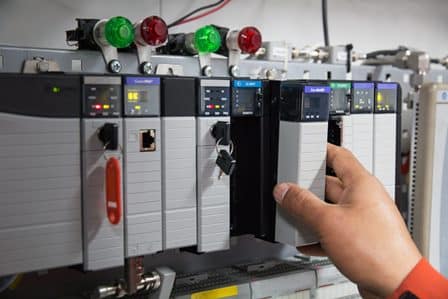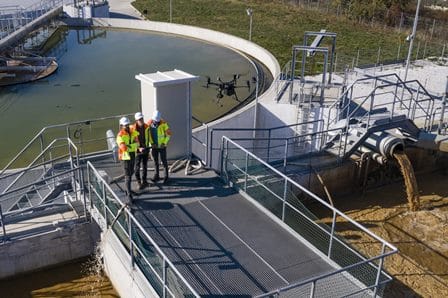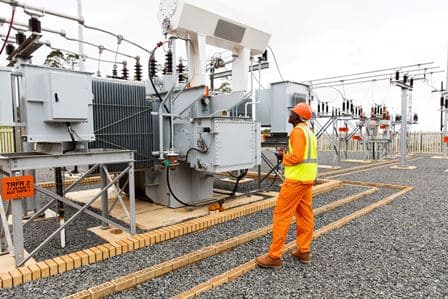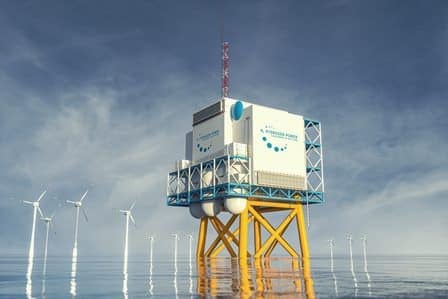52896WA Advanced Diploma of Civil and Structural Engineering (Materials Testing)
Investigation of the properties of construction materials, the principles which…Read moreGraduate Diploma of Engineering (Safety, Risk and Reliability)
The Graduate Diploma of Engineering (Safety, Risk and Reliability) program…Read moreProfessional Certificate of Competency in Fundamentals of Electric Vehicles
Learn the fundamentals of building an electric vehicle, the components…Read moreProfessional Certificate of Competency in 5G Technology and Services
Learn 5G network applications and uses, network overview and new…Read moreProfessional Certificate of Competency in Clean Fuel Technology - Ultra Low Sulphur Fuels
Learn the fundamentals of Clean Fuel Technology - Ultra Low…Read moreProfessional Certificate of Competency in Battery Energy Storage and Applications
Through a scientific and practical approach, the Battery Energy Storage…Read more52910WA Graduate Certificate in Hydrogen Engineering and Management
Hydrogen has become a significant player in energy production and…Read moreProfessional Certificate of Competency in Hydrogen Powered Vehicles
This course is designed for engineers and professionals who are…Read more
This chapter provides a brief overview, including the important terms, naming conventions, and relevant standards.
1 Functional Design Specifications (FDS)
In this chapter a brief overview of control system FDS is given. The important industrial terms and naming conventions are discussed and the standards are highlighted.
Learning objectives
You will learn about:
- Overview of control system FDS
- Essential industry terms and abbreviations used in the FDS
- Naming conventions and standards
- Control philosophy needed in guiding the FDS
Any Supervisory Control and Data Acquisition (SCADA) project will be successful if, and only if, the creating, understanding and execution of the functional specifications are executed perfectly. These technical specifications are important in the overall development and designing of control systems which contain the technical details that lead to the success of the project. These functions are as important as that of the mechanical sections.
For example, consider piping. The complete description of the valves, pumps, chillers, piping specialties and other components used to construct the piping system are given in piping specifications. Designers will not submit a project without this important information for the piping system. In general, this kind of thorough information is not included for control systems. The lack of proper technical specifications for control systems may lead to difficulty in meeting the project’s design objectives. The design process is said to be successful if it contains descriptions of maintenance, operation and commissioning requirements. This leads to efficient building, and ensures the operation runs smoothly.
A functional specification defines what the system should do and what functions and facilities are to be provided. It provides a list of design objectives for the system.
A standard specification of the project should consider what is generally available in the market and what can reasonably be called upon for options. It is of no use to specify aspects which suppliers cannot provide at a reasonable cost and within a sensible time frame. The aim is to match what the manufacturer can offer, within their standard range of equipment. An efficient approach, by the purchaser, is to select standard equipment which is suitable for the manufacturer and then design the power system around the equipment to be purchased. In general, this approach will reduce the amount of time needed to design the power system.
Functional aspects of the specification should be considered carefully. The function of basic equipment such as generators, motors and switchgear will be understood easily. But, in order to gain an understanding of what is required, it is essential to pay attention to the design and performance details. Functionality implies a more interrelated type of existence, as is the case with systems of equipment rather than individual items of equipment.
Functional specifications in the area of process control systems cover the following:
- SCADA systems
- Power management control system
- System computer
- Measuring devices
- Controller set points
- Switchgear
- Rotating machines.
The entire system should be defined functionally and all the elements should be compatible from the conceptual stage of the specification.
Control System Engineers analyze the following, to develop the design and functional specifications of automation systems:
- User requirements
- Procedures
- Design process
- Mechanical equipment
- Problems to identify the system components.
The automation system helps the equipment to function in a required manner. The interface between the hardware and software development, for the automation system, is the responsibility of Control System Engineers.
A FDS is the most important stage in the design of any control system. It provides details of the solution to be implemented, to meet user requirements. It should be accepted by the user and should form the basis of the design for both hardware and software. An excellent FDS clearly specifies the following which are associated with the system:
- Functions
- Operator interactions control
- Sequencing.
Therefore, before the system is developed, the user must confirm whether the proposed solution fully meets the specified requirements or not. A FDS is considered as the basis for the design of the system. It is used during testing to verify and validate the system, to ensure whether all the required functions are present and that they operate correctly.
A FDS has all the information associated with the control system including:
- Details of how each area of the plant operates under automatic control (control philosophy)
- Details of the SCADA system i.e. screen layouts, navigation charts, alarm handling, trending and reporting
- Details of the Network architecture
- Details of any local operator interfaces.
Figure 1.1
Control system design
The FDS should cover:
- Control Modules such as PID Loops, indicators etc
- HMI Graphic displays
- Equipment Basic Control
- Phase Logic
- Operations
- Unit Procedures
- SCADA Recipes
- The Inputs and Outputs of the systems with cards and channels assigned to them.
1.1.1 Benefits of using a FDS
There are numerous benefits provided by a complete and coherent FDS which include time savings of approximately 50% of total time and a saving of resources and money of approximately 25%. These benefits are achieved only after everyone is involved in designing, developing, testing, approving of an application, signing the document containing an ordered list of all design and functional requirements.
By using a FDS (Functional Design Specification):
- The manufacturer knows exactly what to develop & deliver
- The system integrators know exactly what they are working with
- Quality Assurance knows exactly what to test
- The client knows exactly what they will be getting.
Technical terms and abbreviations are easily understood by professionals in one field whereas they may be confusing to others from another field, and may be misunderstood. Therefore, it is necessary to understand the abbreviations and some of the terms that are used in the text and elsewhere in the industry.
The following are the essential industry terms and relevant abbreviations used in functional design specifications:
Table 1.2
Industrial terms and their abbreviations
| Industry terms | Abbreviations |
| AGC | Automatic Generation Control |
| API | Application Programming Interface |
| CORBA | Common Object Request Broker Architecture |
| C & I | Control and Instrumentation |
| CPU | Central Processing Unit |
| CRC16 | 16-bit Cyclic Redundancy Check |
| CSMA/CD | Carrier Sense Multiple Access/Collision Detection |
| CT | Current Transformer |
| DC | Direct Current |
| DCS | Distributed Control System |
| DMS | Distributed Management System |
| DNP | Distributed Network Protocol |
| DOD | Department of Defense |
| DOE | Department of Energy |
| DISCO | Distribution Company |
| DNP/DNP3 | Distributed Network Protocol, version 3.0 |
| DPI | Double-Point Information |
| EMS | Energy Management System |
| EMC | Electromagnetic Compatibility |
| EMI | Electromagnetic Interference |
| EPROM | Erasable Programmable Read-Only Memory |
| FTP | File Transfer Protocol |
| FDS | Functional Design Specification |
| FS | Functional Specification |
| FAT | Factory Acceptance test |
| FMEA | Failure Modes and Effect Analysis |
| FPGA | Field Programmable Gate Array |
| GUI | Graphical User Interface |
| GAMP | Good Automated Manufacturing Practice |
| GAL | Generic Array Logic |
| GENCO | Generation Company |
| GPR | Ground Potential Rise |
| HMI | Human Machine Interface |
| HDS | Hardware Design Specifications |
| I/O | Input/Output |
| IED | Intelligent Electronic Devices |
| ICCP | Intercontrol Centre Communications Protocol |
| IEEE | Institute of Electrical and Electronics Engineers |
| INEEL | Idaho National Engineering and Environmental Laboratory |
| ISO | Independent System Operator or International Organization for Standardization |
| IRIG-B | Inter Range Instrumentation Group format B |
| ISA | Instrumentation Systems and Automation Society |
| IT | Information Technology |
| ITU | International Telecommunication Union |
| LCD | Liquid Crystal Display |
| LED | Light Emitting Diode |
| LAN | Local Area Network |
| MMI | Man Machine Interface |
| MTBF | Mean Time Between Failure |
| MTTR | Mean Time To Repair |
| NIM | Network Interface Module |
| NISAC | National Infrastructure Simulation and Analysis Centre |
| NRC | Nuclear Regulatory Commission |
| NTP | Network Time Protocol |
| OASIS | Open Access Same – Time Information System |
| ODBC | Open Database Connectivity |
| PID | Proportional, Integral and derivative controller |
| POSIX | Portable Operating System Interface |
| PLC | Programmable logic Controller |
| P & ID | Process & Instrumentation Diagram |
| PSU | Power Supply Unit |
| PCS | Process Control System |
| PROM | Programmable Read-Only Memory |
| PSTN | Public Switched Telephone Network |
| PT | Potential Transformer |
| RTU | Remote Terminal Unit |
| REA | Rural Electric Association |
| RTO | Regional Transmission Organization |
| RAID | Redundant Array of Inexpensive Disks or Redundant Array of Independent Disks |
| ROM | Read-Only Memory |
| SCADA | Supervisory Control and Data Acquisition |
| SAT | Site acceptance test |
| SOE | Sequence of Events |
| SNTP | Simple Network Time Protocol |
| SPI | Single-Point Information |
| SQL | Structured Query Language |
| SWC | Surge Withstand Capability |
| TASE | Telecontrol Application Service Element |
| TRANSCO | Transmission Company |
| TCP/IP | Transmission Control Protocol/Internet Protocol |
| T&D | Transmission and Distribution |
| UHF | Ultra High Frequency |
| UPS | Uninterruptible Power Supply |
| UTP | Unshielded Twisted Pair |
| VDU | Video Display Unit |
| WAN | Wide Area Network |
The General Design Principles (GDP) defines the number of conventions to be used.
For example, consider the standard color scheme. In one division of the plant a device is colored red, meaning ‘stopped’, and in another part of the plant the same type of motor is colored red, meaning ‘dangerous condition’. This may lead to disaster, but by following naming conventions, such risks will be reduced.
Adopting a standardized reliable naming convention for devices controlled by the system, will be favorable for scalable and maintainable systems in the long run. In some cases, the naming conventions used are forced on the system by external influences. Therefore, they should be properly documented in the GDP.
Examples of tagging and naming conventions are:
- Graphic symbols
- Instrumentation naming.
Naming conventions and standards are explained in further detail in the next chapter.
Philosophy is a belief or a system of beliefs, accepted as authoritative by some groups. Control philosophy is a guideline for a FDS which describes the basic dos and don’ts and requirements of a FDS from the point of view of the end user. It should describe the following:
- Level of process automation
- Information handling needs
- Operational requirements
- Requirement of flexibility
- Level of control intervention
- Operators work and skill
- Management skills for both organization and data communication
- Level of management needed
- Extent of manual control required
- Extent of the physical area the system is covering
- Type of communication system
- Level of security needed for communication
- Type of control processing.
This chapter summarizes the following:
- A functional specification defines what the system should do and what functions and facilities are to be provided.
- An excellent FDS clearly specifies the following associated with the system:
- Functions
- Operator interactions control
- Sequencing.
- There are numerous benefits provided by a complete and coherent FDS, which include time savings of approximately 50% of total time and a saving of resources and money of approximately 25%.
- It is necessary to understand the abbreviations and some of the terms that are used in the text and elsewhere in the industry.
- Technical terms and abbreviations are easily understood by professionals in one field whereas it may be confusing to others and may be misunderstood
- Adopting a standardized reliable naming convention for devices, controlled by the system, will be favorable for scalable and maintainable systems in the long run
- Control philosophy is a guideline for a FDS, which describes the basic dos and don’ts and basic requirements of a FDS, from the point of view of the end user.
Professional Certificate of Competency in Advanced TCP/IP-Based Industrial Networking
Designed for engineers and technicians who need practical knowledge in…Read moreProfessional Certificate of Competency in Allen Bradley Controllogix / Logix5000 PLC Platforms
Designed for engineers and technicians who need practical knowledge in…Read moreProfessional Certificate of Competency in Arc Flash Protection
Designed for engineers and technicians who work in the electrical…Read moreProfessional Certificate of Competency in Chemical Engineering and Plant Design
Designed for engineers and technicians who need practical knowledge in…Read moreProfessional Certificate of Competency in Circuit Breakers, Switchgear and Power Transformers
Designed for engineers and technicians who need practical knowledge regarding…Read moreProfessional Certificate of Competency in Control Valve Sizing, Selection and Maintenance
Designed for engineers and technicians who need a solid understanding…Read moreProfessional Certificate of Competency in Electrical Power System Fundamentals for Non-Electrical Engineers
Designed for engineers and technicians who need to understand the…Read moreProfessional Certificate of Competency in Electrical Power System Protection
Designed for engineers and technicians who need practical skills and…Read moreProfessional Certificate of Competency in Electrical Wiring Standards: AS/NZS 3000:2018 (Australia and New Zealand Only)
This professional development course is designed for engineers and technicians…Read moreProfessional Certificate of Competency in Fundamental E & I Engineering for Oil and Gas Facilities
Designed for engineers and technicians who need to update their…Read moreProfessional Certificate of Competency in Gas Turbine Engineering
Designed for engineers and technicians who need practical skills in…Read moreProfessional Certificate of Competency in Hazardous Areas and Intrinsic Safety For Engineers and Technicians
Designed for engineers and technicians who need to understand the…Read moreProfessional Certificate of Competency in Heating, Ventilation and Air Conditioning (HVAC)
Designed for engineers and technicians from a wide range of…Read moreProfessional Certificate of Competency in IEC 61850 Based Substation Automation
Designed for engineers and technicians who need to understand the…Read moreProfessional Certificate of Competency in Industrial Data Communications
Designed for engineers and technicians who need to understand how…Read moreProfessional Certificate of Competency in Instrumentation, Automation and Process Control
Designed for engineers and technicians who need to gain practical…Read moreProfessional Certificate of Competency in Machine Learning and Artificial Intelligence
This professional development course is designed for engineers and technicians…Read moreProfessional Certificate of Competency in Mechanical Engineering
This professional development course is designed for engineers and technicians…Read moreProfessional Certificate of Competency in Onshore and Offshore Pipeline Systems
Designed for engineers and technicians who need to gain an…Read moreProfessional Certificate of Competency in Power Distribution
designed for engineers and technicians who need to gain a…Read moreProfessional Certificate of Competency in Practical Machine Learning Using Python for Engineers and Technicians
Designed to use Python Programming to work with machine learning…Read moreProfessional Certificate of Competency in Practical Python for Engineers and Technicians
Designed for engineers and technicians who need to understand the…Read moreProfessional Certificate of Competency in Programmable Logic Controllers (PLCs) & SCADA Systems
Designed for engineers and technicians who need to get practical…Read moreProfessional Certificate of Competency in Project Management for Engineers & Technicians
This professional development course is designed for engineers and technicians…Read moreProfessional Certificate of Competency in Safety Instrumentation Systems for Process Industries
Professional development course designed for engineers and technicians who want…Read moreProfessional Certificate of Competency in Sewage and Effluent Treatment Technologies
Designed for engineers and technicians who need practical skills and…Read moreProfessional Certificate of Competency in Structural Design for Non-Structural Engineers
Professional development course designed for engineers and technicians who need…Read moreProfessional Certificate of Competency in Substation Design (Main Equipment)
Professional development course is designed for engineers and technicians who…Read moreProfessional Certificate of Competency in Substation Design (Control, Protection and Facility Planning)
Designed for engineers and technicians who need to gain practical…Read moreProfessional Certificate of Competency in the Fundamentals of Process Plant Layout & Piping Design
Professional development course is designed for engineers and technicians who…Read moreProfessional Certificate of Competency in Practical Mechanical Sealing
This professional development course is designed for engineers and technicians…Read moreProfessional Certificate of Competency in Fundamentals of Road Construction
This professional development course is designed for engineers and technicians…Read moreProfessional Certificate of Competency in Specification and Technical Writing
Designed for engineers and technicians who need to understand how…Read moreProfessional Certificate of Competency in Hydraulics and Pneumatics
Overview of all aspects related to the construction, design, operation,…Read moreProfessional Certificate of Competency in Big Data and Analytics in Electricity Grids
This course explores the use of big data & data…Read moreProfessional Certificate of Competency in Renewable Energy Systems
This course covers various renewable energy systems that are popular…Read moreProfessional Certificate of Competency in Smart Grids
A smart grid is an electricity network that uses digital…Read moreProfessional Certificate of Competency in Hydrogen Energy – Production, Delivery, Storage, and Use
Hydrogen energy short course designed for engineers and professionals interested…Read moreProfessional Certificate of Competency in Earthing and Lightning Protection
Designed for engineers and technicians who need to understand the…Read moreProfessional Certificate of Competency in Building Information Modelling (BIM)
This professional development course is covering practical aspects of using…Read more
















































